Welcome to Anatomy of a Queer Sex Scene, a series by Drew Burnett Gregory and Kayla Kumari Upadhyaya about queer sex scenes in film. Today Kayla writes about The Handmaiden, Park Chan-Wook’s film adaptation of the iconic lesbian novel Fingersmith by Sarah Waters.
The horniest parts of The Handmaiden aren’t the film’s climactic sex scene — a moment we see twice, context and perspective bending our experience of it — or its final sex scene set to melodious bells. The horniest parts of The Handmaiden wouldn’t really be called sex scenes by the average viewer and certainly not by the vast majority of straight viewers. But to me, they are sex. And to merely call them moments of sexual tension or erotic foreplay is to not only subscribe to a narrow view of sex but also to deny how queerness historically and continually blooms right under the watchful eye of the heteropatriarchy. Push us to the margins, and we’ll find ways to fuck in those margins.
I had sex with women before I had sex with men, but I still considered myself straight. Not bisexual. Not uncertain. I thought myself staunchly heterosexual, these sexual experiences with other women self-erased, downplayed as somehow not real. When I came out, I turned my queer self-discovery into a simultaneous anthropological exploration in the field and academic exploration at the desk. What I mean is I started fucking a lot and reading queer theory.
It didn’t take long into these dual processes for me to realize this self-erasure had been rooted in an internalized rigid and heteronormative understanding of what sex is. I learned new definitions of sex, created new definitions of sex. I unlearned the rules of before: that sex required penetration, that sex required orgasm. (In truth, a lot of the sex I’d had with women I thought “didn’t count” actually did meet these markers of certified normative straight sex, and yet, I still dismissed the encounters as somehow unreal.)
After coming to better understand these previous sexual experiences, I queered my own memories even further, coming to understand all the ways gaze and touch allowed me to access my latent desires without even realizing it. All those backrubs that lingered a little too long, all those sleepover games that required close mouths and tickle-pricked skin. There were so many ways girls could touch each other without it being deemed deviant or wrong.
In The Handmaiden, there are two significant instances of erotic touch and gaze prior to central characters Lady Hideko and her handmaiden Sook-hee fucking by conventional standards. (I’m not going to delve too specifically into the film’s plot in this essay, but my review from 2020 does so if you’d like more context.) In the first, one of my favorite erotic movie scenes of all time, Sook-hee files Hideko’s too-sharp tooth down with a thimble, inserting her thumb into Hideko’s mouth while she’s giving her a bath. Sook-hee takes her time with the tooth, and her eyes move down to Hideko’s tits perched just above water level.
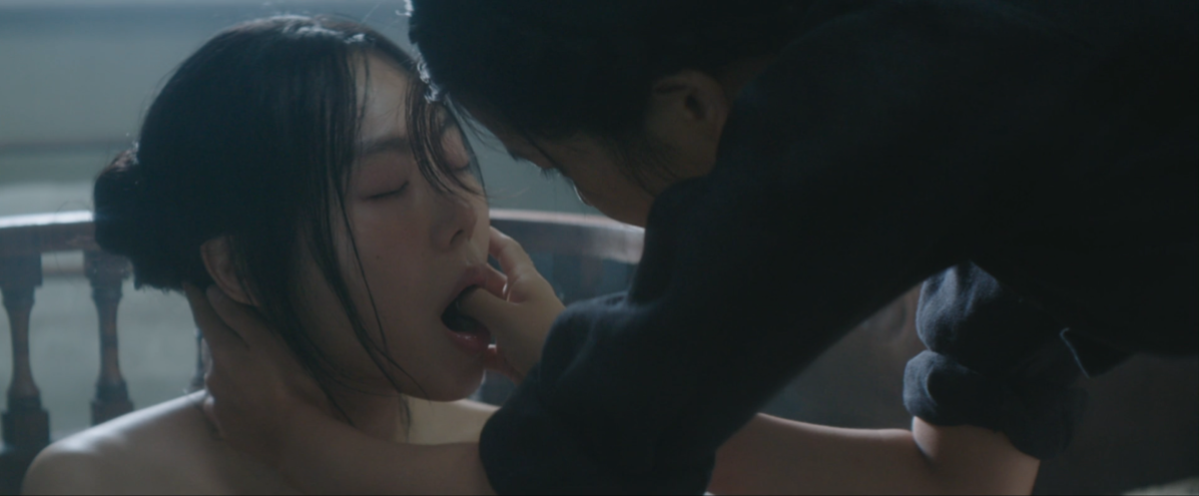
Later, Hideko dresses Sook-hee up as a lady, a sort of class-based cross-dressing. In the privacy of Hideko’s bedroom, she tightens Sook-hee’s corset, powders her face, does her hair in an elegant bun. A shot from behind the two women shows their twinned hairstyles in close proximity, a doubling of sorts. The boundaries between them set by society are collapsing. It’s in this moment that we get another instance of erotic touch. Sook-hee undoes Hideko’s dress, and we hear her internal monologue, which leaves no room for interpretation as to just how intimate Sook-hee views this form of touching Hideko:
“Ladies truly are the dolls of maids. All these buttons are for my amusement. If I undo the buttons and pull out the cords, then, the sweet things within, those sweet and soft things…If I were still a pickpocket, I’d slip my hand inside.”
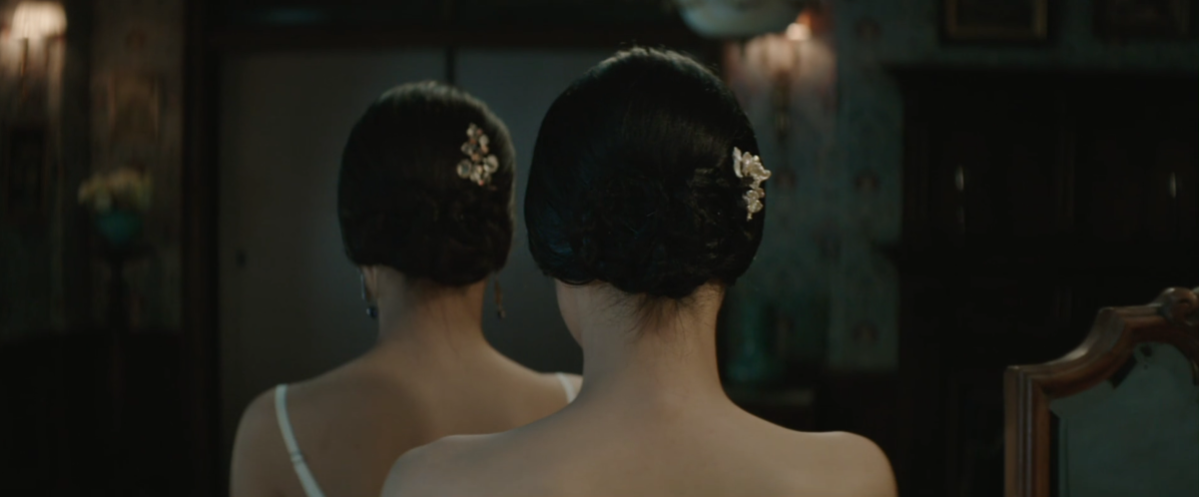
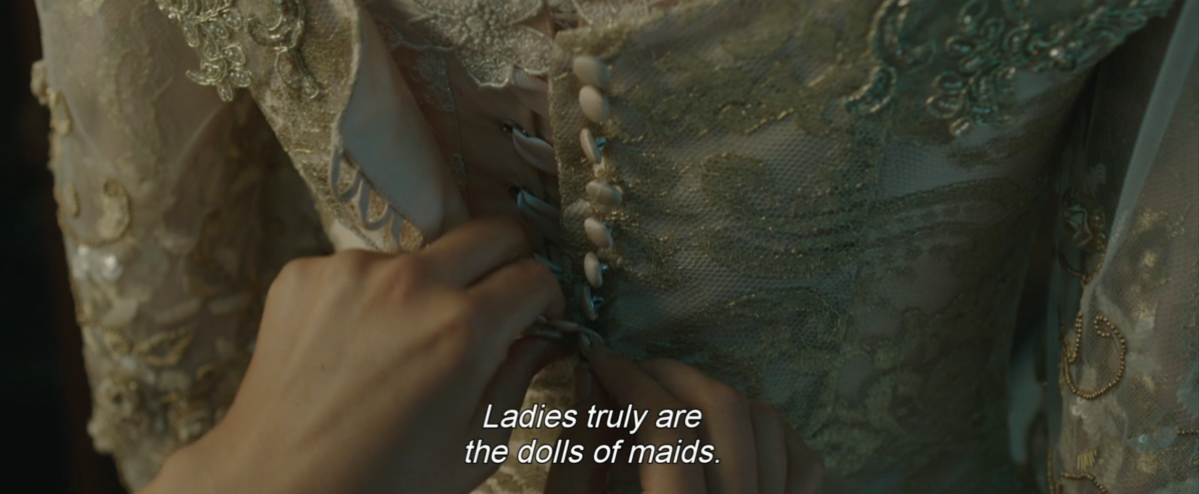
Period dramas that contain romance often confront and disrupt categories of class and power, and it’s impossible to consider the dynamics between Sook-hee and Hideko outside of the context of the film’s historical setting of Japan’s occupation of Korea. While other characters frequently regard Sook-hee as expendable or otherwise underestimate her for being not just poor but also Korean, that derision never comes from Hideko, whose very first observation about Sook-hee is her beauty. Hideko is pedestaled by other characters — men, especially — for her beauty, for her wealth, for being the pinnacle of Japanese femininity in their eyes. Sook-hee and Hideko’s love is socially forbidden in more ways than one. And yet, both women find ways to transgress their social positions and the heterosexual expectations forced upon them.
To an outside, oppressive gaze, Sook-hee is perhaps merely only fulfilling her handmaidenly duties by inserting her thimbled thumb into Hideko’s mouth or by unfastening her many buttons. But Hideko and Sook-hee’s body language in the bathtub scene and Sook-hee’s narration in the dressing/undressing scene highlight that, for them, they’re stepping far outside these expected roles. They’ve found ways to access erotic touch that not only are imperceptible to the detection of others but perhaps even hidden to themselves.
And that tension doesn’t detract from their agency or desire. Neither Hideko nor Sook-hee are passive in the ways other characters think they are. They know what they want, just like the girls whose hair I braided and who braided mine knew what we wanted, too. But sometimes that type of carnal, urgent knowledge is still at odds with how we really think of ourselves.
Lesbian period dramas, specifically, are often mocked for this suffusion of erotic tension in “safe” forms of looking and touching. Heavy eye contact made across a room, extended hand holding, the unbuttoning of a complicated garment, such as the scene of this exact nature we see in The Handmaiden. These moments get derided for being too tame, for lacking explicit sexuality. They’re held up as proof a film ultimately tempered its queerness, softened the edges of its lesbian erotics in order to present something more palatable to a wider (straight) audience.
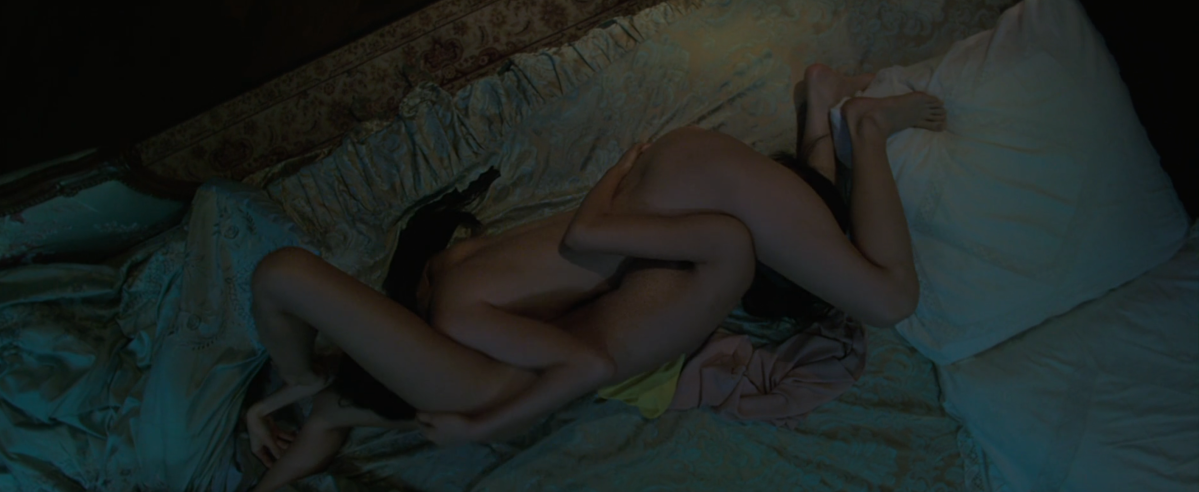
Now, one would be silly to lodge this complaint toward a lesbian erotic thriller like The Handmaiden, which does indeed contain explicit sex scenes, too. And despite all my waxing poetic on these other scenes, I do find the film’s central sex scene incredibly worthy of dissection. It’s hot. It’s sex so nice we see it twice. Jokes aside, the differences in how we see the same sex scene unfold at two different points of the film deepen the dynamics and meaning of the sex itself.
But I have my reasons for wishing to focus more intimately on these alternative sex scenes, the ones you might think don’t depict sex at all. These reasons are personal: I want to give myself permission to cast a new lens on my own memories of early erotic touch and gaze. But my reasons are cultural, too. I think critiques of lesbian period dramas are sometimes too broad, too dismissive of the power and radical nature of queer eroticism that looks acceptable to a heterosexual gaze and yet functions on a different level for the characters themselves. It’s why I want to take things to an extreme place and say these scenes from The Handmaiden aren’t just sexual; they are sex. Mainly because my reading is that the characters engaging in the touch would certainly think so. And sometimes, the truest definition of sex is the one we write ourselves.
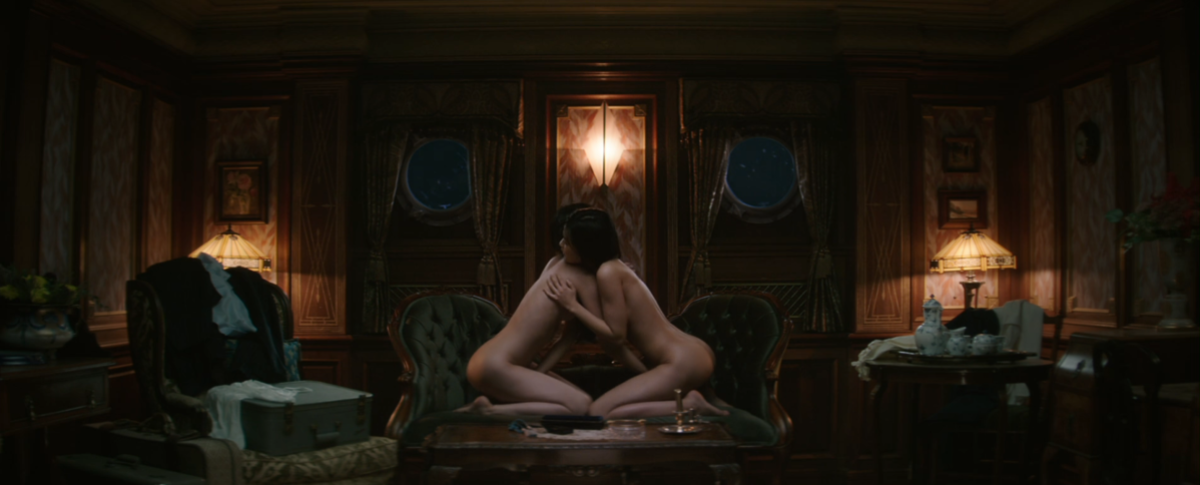



Thank you SO much for this!! The Handmaiden is such an incredible movie and I loved this article.
both the bathtub and dress-up scenes are my favorite erotic moments in film that I’ve ever seen, and I think about them all the time. like you talked about, there’s something deeply queer about it that resonates with how I have sex as well, how we don’t have to follow conventional cishet rules for “what counts” and I love that, there’s so much freedom and creativity in it
Thank you! So glad it resonated!
I adore this! The tooth moment is so, so erotic in both The Handmaiden and Fingersmith (the Sarah Waters book), when I read it for the first time as a baby gay it absolutely blew me away. Also, have you read Carol Ann Duffys ‘Warming Her Pearls’ ? It’s very similar to the ‘doll’ scene here, and SUCH a poem
I have not read Warming Her Pearls! Thanks for the rec!
Yes to every word of this! The conventions of lesbian period dramas are undoubtedly easy to parody, and I laugh at the memes as much as the next sapphic, but I also want to scream when cishet critics complain, for example, that there were no sex scenes in Portrait of a Lady on Fire. As if it is not one of the most erotic films ever made!
At one point Héloïse asks “When do we know it’s finished?”, ostensibly about the portrait, and implicitly about when Marianne will have to leave, but the line surely also pings, at least for queers, as a question about defining sex and where it begins and ends. Your last line, about drawing those lines (no pun intended) for ourselves, gives me an excuse to quote another of my favourite lines: “Do all lovers feel they’re inventing something?”
I had forgotten how stunning The Handmaiden is and I cannot wait for a long overdue rewatch with this excellent article in mind. Plus I am a sucker (pun intended) for fingers in mouths (:
Ahhhh love all of this! Thank you for reading!
Not this misogynist garbage being praised for how hot it is 🙄 The good scenes (such as the thimble one) are just a male gaze-fied version of the BBC’s version (which was directed by a woman) and the rest of the film is literally self aware musings on the male gaze. The sex scenes are unnatural and posed for the camera in the same way mainstream made-for-men “lesbian” porn is. It’s not hot, it’s sexist, objectifying and lazy.
I have complicated feelings about this movie! when I first saw it I found the sex scenes a little much, and I was always bothered by the fact that a man concerned w/ his masculinity gets the last word (something like, ‘at least he didn’t take my dick!’) while they do this weird performative final sex scene. but I love the story and pretty much always cry at the scene of them raiding the library.
I really liked Verily Bitchie’s take on the movie (https://youtu.be/3LcV2HmZUfY?si=Nese9AnbkIO_z-Wv). they’re pretty critical, but I found their reading basically spot on in terms of the film’s use of gaze. now I enjoy this movie the same way I do Blue is the Warmest Color – I skip the traditional ‘sex’ scenes and can still really love the story/characters/aesthetics.
but also — agree that I love the tooth filing scene, and ultimately think that hotness is really in the eye of the beholder. I think that just because something might meet our/my criteria for being ethically on the up and up doesn’t mean we can’t still find it hot.
oops — **just because something might *not* meet my/our criteria…
The Handmaiden does something very unique with sexuality and romance I’ve never seen before. It’s a period piece set in the early 1900s in South Korea and it’s a love story between two women, Hideko and Sook-Hee where you’d think them being same sex would somehow matter in their dynamic AND IT DOES NOT. It neither matters in their attraction to one another nor does it even matter to the plot of the film.
That’s because the film presents their sexualities as just results of other more fundamental internalized aspects of their entire being that just happen to include romantic feelings for each other. Hideko’s nature is to imitate and Sook-Hee’s nature is to nurture.
Hideko imitates everything around her including the feelings around her. She imitates multiple people’s way of speaking throughout the film repeating specific phrases people say around her even to herself when no one is listening. She also imitates people’s mannerisms and opinions and internalizes them thinking certain men’s opinions of her are true while repeating those things they said as if they were her own observations she came up with about herself.
Her main attraction to Sook-Hee comes from the fact that she can tell Sook-Hee is genuinely kind and loving of her so she imitates that to be kind and loving to her back. Even when it comes to her sexuality, she reads pornography in which women are in anguish from being raped and demeaned by men and so she herself feels despair from it and a revulsion of men. And the one time she reads a story where the women are actually enjoying each other it’s a lesbian fetishization story but she enjoys it since the story is actually about them enjoying themselves too.
Sook-Hee’s understanding of love is from parental nurturing. In her backstory one of the first things she says is that if she could produce milk she’d breastfeed all the babies she took care of. Her first acknowledgement of attraction to Hideko is her comparing Hideko to a Doll that she lovingly dressed and tends to. The first intimate moments the two share are when Hideko plays into being a scared child clutching her doll as Sook-Hee cuddles with her to sleep and the other is when Sook-Hee files down Hideko’s tooth like a child while bathing her. Her nickname for Hideko is even “Baby-Miss.”
Very little acknowledgment is ever made of them being women and it’s achieved through having their relationship basically NEVER exposed by a single person in the story. No character besides them ever learns of their romance and they themselves are never shown to be attracted to one another because of they are women. Their entire attraction to one another and even conflict regarding this attraction are all based on their bizarre personality quirks.
In fact the scene where the two first outworldly acknowledge their love is when Sook-Hee takes the role of Hideko’s mother to tell Hideko that her mother would be glad she was born and just as well, we get Hideko’s internal monologue where she compares this to the love and companionships she read of in a book. Hideko needs to imitate a book to even start sorting what her feelings are in this moment while Sook-Hee can most clearly tell Hideko she loves her by saying so as Hideko’s mother.
Just as similarly, when the two are in conflict regarding their romance, it’s because of the same personality defects. Sook-Hee sees Hideko as a child and so she feels her to be naive and is fine gaslighting her about her emotions like you would a fussy child you believe you know better than. And just as well Hideko immediately reacts to being lied to and belittled with anger and violence as those are the responses she has seen are warranted in these situations and imitates them despite her loving Sook-Hee and actually being very aware of where Sook-Hee’s trepidations are coming from.
This film has broken a mold not only in queer romance but in general with depicting how characteristics of a person shape the way the love and romance of the story itself play out. There’s the trope of a Barbaric and Vicious man somehow having this extremely loving relationship with the kindest woman. Such tropes don’t interrogate how this person’s propensity for, and sometimes enjoyment of, cruelty would DEFINITELY affect what type of woman they love and how they love them and what type of woman even loves such a person to begin with. It’s always treated as a contrast that a character can have such varying contradicting aspects within them when the more interesting thing is to explore how the two things would definitely overlap.
The overlaps chosen for imitation and nurturing with the wider plots of the two characters are what make the love that grows between them feel so organic. Sook-Hee is a thief who people expect is entirely motivated by greed and she only survives the plot because this is a misreading and she’s actually very nurturing and no one ever knew this about her until she was pulled out of her poor surrounding into an environment where her Nurturing side was the primary role she was to inhabit. Hideko is a sheltered heiress who behaves exactly the way everyone around her expects her to behave as cruel and selfish as they think she is but they don’t realize that she’s only doing so because that’s exactly what they expected already. They do not believe she could be loving but because all she does is imitate what’s in her surroundings and once genuine love somehow makes it into these surroundings she’s a whole other person and this once again ensures her survival at the end.
These two don’t necessarily grow as characters in major ways through the film, it’s more like they are revealed to have actually been both much deeper and yet much simpler characters all along. With these primary driving motivations that were simply out of view from anyone but each other. Hence this is a period piece queer romance that never even involves outsiders ever affecting the romance itself. It’s entirely about these two people revealing themselves to one another piece by piece to show just how simple the specific attributes that were innate to them fit so well with each other.
Sook-Hee and Hideko’s personality attributes not only informing their attraction but their general view of life is an amazing achievement in writing outside of the shackles of both mainstream romance and queer romance tropes alike and I can only hope we see more of this in stories to come.